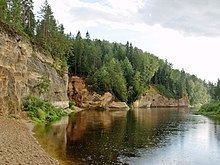Overlies Plavinas Formation Other Arenite, Quartz Named for Gauja | Underlies Amata Formation Thickness 80 m (260 ft) Primary Sandstone | |
 | ||
Sub-units Sietin MemberLode Member | ||
The Gauja Formation is a Middle Devonian fossil locality in Estonia and Latvia. It is named after the Gauja River, where it is exposed along the banks.
The Gauja Formation has a maximum thickness of 80 m (260 ft). It is composed of weakly to moderately cemented layers of fine-grained to very fine-grained sandstone. The layer is predominantly light to yellowish-gray in color, but can be pinkish brown or variegated. It is mostly composed of quartzose arenites. It is overlain by the 30 m (98 ft) thick Amata Formation and the Plavinas Formation.
The Gauja Formation contains two cyclic members. The lower layers are known as the Sietin Member and are composed mostly of sandstone with a thin layer of siltstone at the top. It has yielded numerous fossils of fishes. Among them are Asterolepis, Bothriolepis, Glyptolepis baltica, Laccognathus panderi, and Megadonichthys kurikae.
The upper layers are thicker, and the lower part of it is known as the Lode Member. The Lode Member dates from the Middle Devonian and is composed of light colored sandstone. The area is indicative of a near-shore environment of retreating sea. Only large plant remains and miospores are known from this member. Examples of which include Hostinella, Archaeopteris, Retusotriletes rugulatus, and Ancyrospora. Palynological studies indicate that the Middle to Upper Devonian boundary may exist in this member.
